Author: Amanda Lillie
3. Between street and piazza: the Florence of Saint Zenobius
The life of Saint Zenobius provides a test case for exploring the ways in which Florentine artists depicted localities. If the legends of Saint Zenobius recorded particular sites for his life and miracles, how did artists interpret those sites and to what extent did they make them recognisable? Saint Zenobius (about 350 – about 424) was not the first Bishop of Florence, but he was the first to be born a citizen of Florence and to be canonised, and thus he became an exemplar for all subsequent Florentine bishops.10 Although Florence had the Virgin Mary and Saint John the Baptist as its prime patron saints, they were venerated across the whole of Europe, whereas Saint Zenobius’s Florentine identity gave him special local powers.11 This distinction is expressed in the five predella panels below Domenico Veneziano's Saint Lucy altarpiece where the other saints – the Virgin, John the Baptist, Francis and Lucy – are depicted in generic landscape or architectural settings, whereas Zenobius is painted in a specific Florentine street (fig. 14).12
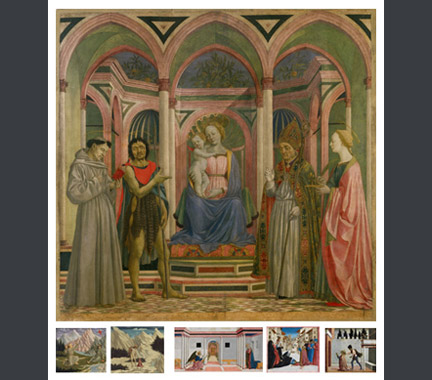
‘Madonna and Child’, Galleria degli Uffizi, Florence. © Photo Scala, Florence - courtesy of the Ministero Beni e Att. Culturali; ‘Saint Francis’. © National Gallery of Art, Washington D.C.; ‘Saint John’. © National Gallery of Art, Washington D.C.; ‘Annunciation’. © The Fitzwilliam Museum, Cambridge / Photo Scala, Florence; 'A Miracle of Saint Zenobius.' © The Fitzwilliam Museum, Cambridge. ‘The Martyrdom of Saint Lucy’, Berlin, Staatliche Museen Preussischer Kulturbesitz, Gemäldegalerie. © Photo Scala, Florence / BPK, Bildagentur für Kunst, Kultur und Geschichte, Berlin.
One of the saint’s most famous miracles is said to have occurred in Borgo degli Albizzi where Zenobius brought back to life the child of a French widow, who had left her ailing son in his care while she went on a pilgrimage to Rome. Earlier surviving images of the miracle by the Maestro del Bigallo (‘Saint Zenobius’, about 1240–50, Museo dell’Opera del Duomo, Florence), and Giovanni del Biondo (a panel on the north entrance pier of Florence Cathedral, figs 15 and 16), do not include recognisable locations.
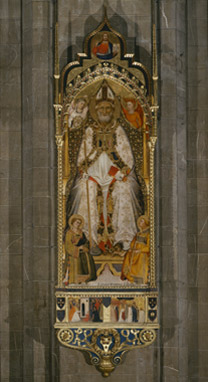

Domenico Veneziano’s therefore seems to be the first surviving image to develop the street of Borgo degli Albizzi as the specific setting for the miracle (fig. 17).
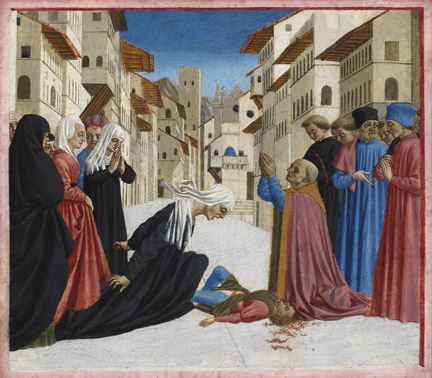
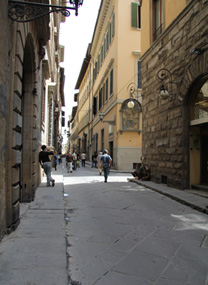
Certainly, this spot had assumed a sacred status well before the 15th century, for documents record how in 1286, 1370 and 1411 the ceremonial entries of new bishops into Florence included a special halt in Borgo degli Albizzi (fig. 18).13 Archbishop Antoninus performed this ritual during his ‘adventus’ on 13 March 1446, when he paused to kneel and pray in the exact place where Zenobius had performed his miracle;14 and Mazza’s 1475 ‘Life of Saint Zenobius’ refers to the marble stone marking the miracle’s location, perhaps the inscribed plaque which is still in place in Borgo degli Albizzi.15
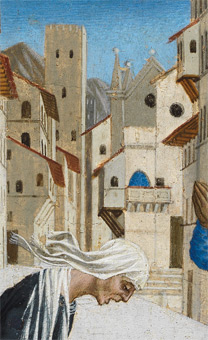
The partial glimpse of what is undoubtedly a church, at the bottom right-hand side of the street in the position then occupied by San Pier Maggiore (now destroyed) when looking down Borgo degli Albizzi from its west end, is certainly not a coincidental placing of a generic ecclesiastical building (fig. 19).16 The church in the painting has an idiosyncratic profile, its white west front catching the sun, with wide steps leading up to its main entrance from a piazza, an oculus under its gabled end and, projecting on the left side of its façade, an outdoor pulpit supported on triangular console brackets, with a pointed blue archway perhaps representing a fresco or cloth to honour whoever preached there.17 Behind this main façade, a second, steeply gabled end rises, looming in shadow with its own round window. This second gable seems to mark the end of the church’s transept, with a thin campanile squeezed into the space between.
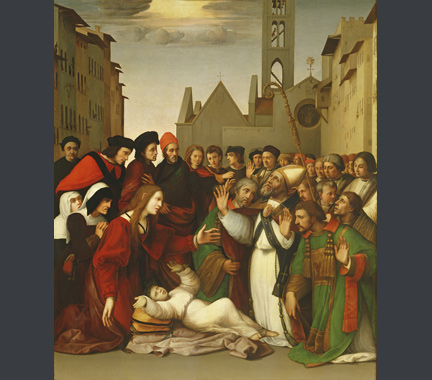
Ridolfo Ghirlandaio’s much larger depiction of the same miracle in an altarpiece of 1516–17 presents a far more legible record of the façade of San Pier Maggiore, which confirms the accuracy of Domenico Veneziano’s rendition (fig. 20).18 Here is the same relationship between the straight street in the foreground and the church façade at right angles to it. Here too is the second west-facing gable end rising behind the façade, which in Ridolfo’s version is clearly attached to the church’s north transept.19 This distinctive architecture is surely intended to be a recognisable representation of a specific group of buildings and a particular site.
Creating the urban vista
Although the palaces in Domenico Veneziano’s predella panel are most probably not the exact houses on Borgo degli Albizzi in the 1440s, he planned his street fronts with great precision. Their perspectival compression is extraordinary. On the left side of the street alone 15 houses (‘palazzi’ and ‘case-torri’) form the urban vista. Each building is distinct and countable, a case of urban ‘varietà’, with different heights and roof lines, some crenellated, eaves overhanging at varied angles, with two tower houses, and the very last (dark grey with crenellations) probably representing the city gate. The left-hand side of the street is the female side. The right or male side – the side associated with the saint – is seen at a less acute angle and its façades are therefore more visible, but the buildings are also considerably wider and grander, consisting of five fine city palaces followed by the church of San Pier Maggiore with its piazza.
Domenico Veneziano conceived his narrative architecturally from the start, as the two groups of figures are set up in close relation to the street and its rows of buildings. The figure groups and the house fronts support each other, like framing vertical bulwarks for the main action that takes place on the horizontal plane of the street, empty except for the child’s body, the kneeling mother and the saint. This type of structural coherence lends power and clarity to the composition of a small-scale predella.
This was a new type of painting in 1440, built around a particular type of street, the ‘borgo’, which was paved, was straighter and wider than earlier medieval thoroughfares, and directly connected key central points with gates in the city walls.20 Even on this small scale, Domenico Veneziano conveys community and social cohesion in the overlapping, tightly clustered, interactive groups, fully inhabiting their neighbourhood. The image manages to represent the miracle as something domestic, local and familiar, at the same time as it is outdoors, public, and civic. Other perspectival street scenes before this date focused on one side of a street, but this strictly axial composition places the road itself at its centre with its crazy paving corresponding to the type of paving actually used in Florence at this date. The place has become the subject as much as the miracle, and the' locus' itself has become sacred.
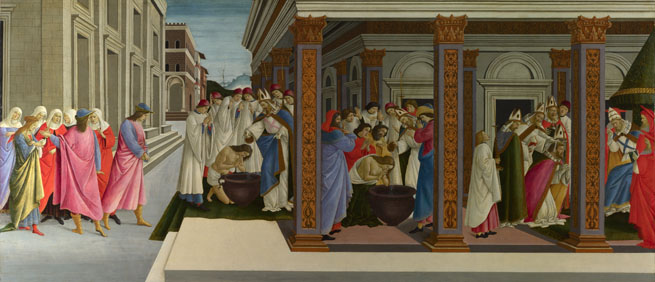
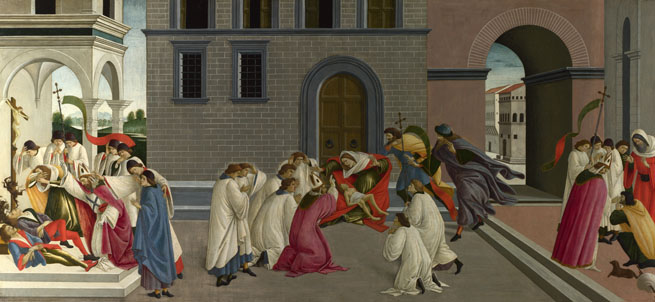
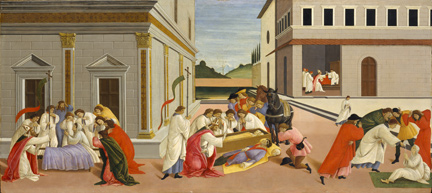
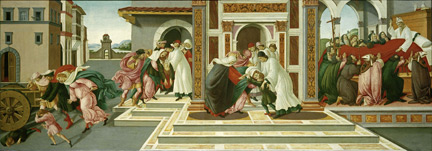
Botticelli's four surviving spalliera panels of the life and miracles of Saint Zenobius (figs 21-4) include 15 episodes, which form a visual counterpart to Clemente Mazza’s ‘Life of Saint Zenobius’ of 1475. The interplay between hagiographic texts and images is intriguing, and it is possible that Mazza’s extended reportage of the widow’s desperate appeal to Zenobius was already influenced by Ghiberti's and Domenico Veneziano’s emotive depictions of the resurrection of the French widow’s son and probably also by religious drama, sermons, and images which no longer survive.
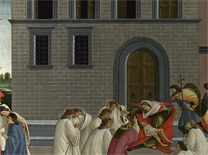
Botticelli’s account is different from Domenico Veneziano’s in key respects.21 The wider spalliera format led him to abandon the compressed and strictly axial perspectival focus of the street and to adopt a piazza setting which is architecturally more varied and spatially expansive. Despite the dramatic gestures, the more fluid, responsive movements and open-mouthed cries, the result is less emotionally oppressive and intense than Domenico Veneziano’s because of the different urban setting. In the National Gallery’s ‘Three Miracles of Saint Zenobius' (fig. 22), Botticelli’s panel is dominated by grand buildings elevated on stepped podia: to the left the open loggia of a shrine or oratory, to the right a deep archway, and in the centre a fine palazzo whose asymmetrical façade recalls that of the Palagetto Corsi-Horne built between about 1495 and 1502 (figs. 25 and 26).22
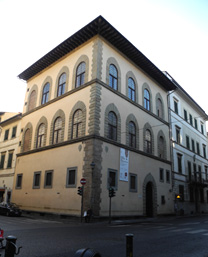
The architecture plays to the narrative in every sense. The three buildings are differentiated as building types and in their architectural materials and colours; and each building is set on its own stage, one for each miracle.23 Thus, the episodes in the life of Saint Zenobius are separated yet unified within a single urban piazza, like chapters within the book of the ‘Life’ or like scenes in a mystery play.
The architectural impression is close to the aesthetic created by the architects Giuliano da Sangallo and Simone del Pollaiuolo (known as 'Cronaca') in the last decades of the 15th century. Botticelli’s preference for rectangular piers and flat pilasters rather than round columns is striking, as are the crisp, sharply projecting mouldings of cornices, entablatures, door and window frames, often closely ranged across façades. Botticelli was certainly capable of inventing a strong new architectural idea, as in the case of the arcade surrounding what is supposedly a church framing the two baptisms and the consecration in ‘Four Scenes from the Early Life of Saint Zenobius’ (fig. 27).
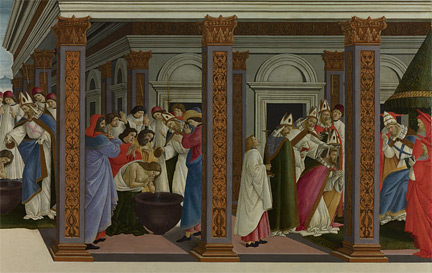
The visible parts of this building imply that it is a tetrastyle peripteral temple with square piers, a splendid design that was not, however, adopted for a building during the period.24 From the 1470s artists began to explore the type of idealised architectural representation epitomised by the city views now in Urbino (fig. 28), Baltimore and Berlin and by intarsia decoration in the study of the Ducal Palace in Urbino (fig. 29).

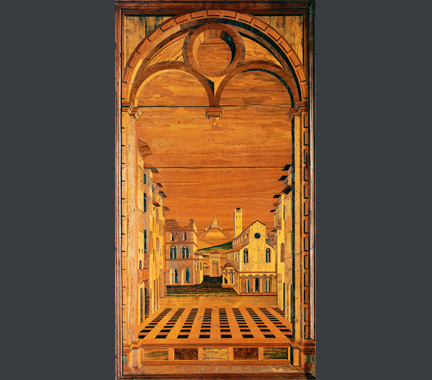
As spalliere, or paintings designed to be incorporated into wall panelling, the settings of Botticelli’s Saint Zenobius series contribute to this genre of architectural depiction. All four of these cityscapes are generated around the concept of the piazza as a paradigmatic urban space creating axial vistas of wide, clean, uncluttered streets and squares that ennoble the image of the saint and his city. The effect, for this most local of saints, is quintessentially Florentine; but Botticelli achieves this through allusion and generic similitude, not through directly reproducing the localities in which the miracles took place. One possible exception is the ‘Three Miracles of Saint Zenobius’ which, significantly, includes the resuscitation of the French widow’s son. Here the arched passageway on the right (fig. 30) is reminiscent of the Volta di San Pietro on the north side of Piazza San Pier Maggiore, with a glimpse of the palaces in Borgo Pinti beyond the arch (fig. 31).
At right angles to the ‘volta’, on the far right-hand edge of the picture, is a doorway which appears to belong to the church of San Pier Maggiore. But unlike the irregular configuration of San Pier Maggiore in Domenico Veneziano’s predella, Botticelli’s buildings are too smoothed over to register as unequivocal portraits of place and appear more like ideal distillations.
A processional route
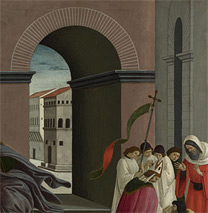
Botticelli emphasises the processional character of the narratives and of their civic environment (see figs. 21–4). The frieze-like figure groups are mostly composed of clerics and young acolytes wearing long white surplices over their cassocks, looking like the members of a ‘laudesi’ confraternity or church choir following a processional route, pausing at each stage to enact the requisite rite at a predetermined place.
The city is not merely the background setting for the rituals and miracles, for its streets, piazzas and buildings created the processional routes, and as is clear in early versions of the written ‘Life of Saint Zenobius’, the places themselves became sacramental through their participation in the holy life of the Florentine saint.
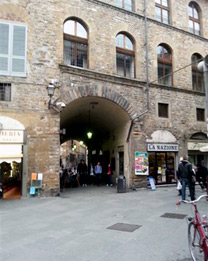
As if to recreate a series of ‘loci’ Botticelli literally stages his narrative, employing raised daises and defined areas of streets and piazzas, one for each episode in the narrative. But the architecture also enhances emotion and meaning, as in the episode shown in ‘Four Scenes from the The Early Life of Saint Zenobius’ (fig. 21) when Zenobius leaves the group of women in the shadow of the family palace and steps out into the empty street, turning his back on marriage and secular prestige. The ‘loci’ in the 'Three Miracles of Saint Zenobius' (fig. 22) are scrupulously designed in relation to the narrative so that the exorcism on the far left takes place beneath a Crucifix in an oratory, the banished devils fleeing right under the gaze of Christ dying on his Cross. In the New York panel (fig. 23) the resuscitation of the boy who carried relics across the Apennines takes place before a landscape with distant hills.
Read further sections in this essay
- 1. Introduction
- 2. Between real and imagined places
- 4. Imagining the Temple in Jerusalem: an archetype with multiple iconographies
To cite this essay we suggest using
Amanda Lillie, 'Place Making' published online 2014, in 'Building the Picture: Architecture in Italian Renaissance Painting', The National Gallery, London, http://www.nationalgallery.org.uk/research/research-resources/exhibition-catalogues/building-the-picture/place-making/between-street-and-piazza
